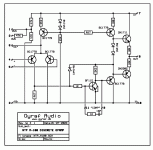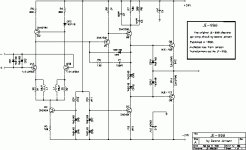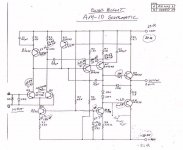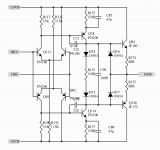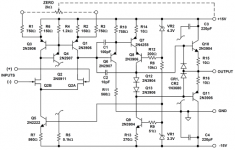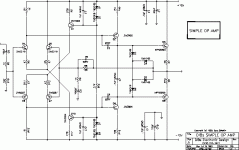May I ask why 30 ohms? I think opamps are usually spec'd for 600 ohms.
This amplifier will be used for other than driving 600 ohm input Z's. Driving headphone z is a current application for such circuits. About 1/2 of the headphones are below 600 Ohm Z.
30 ohms is not uncommon. For example, two of my headphones (Senn HD800 and HiFiMan HE6) are 300 and 50 Ohms.
Ic are limited in power handling but this is a discrete design and no such limitation need exist. Thx - RNM
Last edited:
You professional guys want for DIY audience to design a "discrete opamp" that you would use in your commercial designs? 🙂
I hope we see a design come of this thread that is new or at least has some novelty, tweak or improvement over circuits most of us have seen shown here to death. That includes circuits that some experts believe is new but are available all over the internet and as old as 30 or more years. Possible ???
I don't disagree with this, but as always, the devil is in th detail. Probably 80% of those designs have the wrong trade offs and are subsequently sub optimal.
Yes, i also hope we se something novel and with 8 trannies, it's going to have to be.
🙂
Yes, i also hope we se something novel and with 8 trannies, it's going to have to be.
🙂
True but one designer may optimize for a different reason which may not be obvious to you but important factor to him, so how can one judge that his way is not optimal afterall it is trade offs. For instance J Curl will optimize for wide bandwith but this is not neccesarily good for THD while Edmond will go out of his way to post lowest possible THD. Which one is suboptimal ??
I think the percentage is much smaller than that, probably less than 10 percent when it comes to commercially available equipment.
I think the percentage is much smaller than that, probably less than 10 percent when it comes to commercially available equipment.
Lots of talk, no action. sigh....
 Patience please, geniuses at work on it. 😀 😀 😀
Patience please, geniuses at work on it. 😀 😀 😀And then comes the dissapointment of seeing something weve seen years ago.....


Patience please, geniuses at work on it. 😀 😀 😀
And then comes the dissapointment of seeing something weve seen years ago.....
It doesn't have to be unique. It just has to meet specs.
Four of those already dont qualify, over 8 transistors.
No CFB types ???
current sources are not counted. But, even so, if you like it and it has more than 8, then since you're a genius you can fix it, right? 😛
I saw some CFB types, but they had way more than 8 transistors. Do you have any examples you'd like to share or are you just going to talk talk talk???
Anything less complex than a Jensen 990 is a joke, and not worthy of consideration. We are looking for EXCELLENT circuits that we would use in the best audio equipment available today.
Anything less complex than a Jensen 990 is a joke, and not worthy of consideration. We are looking for EXCELLENT circuits that we would use in the best audio equipment available today.
I thought you already did that? You're asking US to design something for you? 😕
That would be like Luke Skywalker teaching Yoda how to use The Force.
Digikey is listing both the J76 and K213 series as obsolete. So that looks like a dead end then.
Toshiba has some high-gm FETs (even better on paper than Renesas) but they're rather low voltage and have higher thresholds than the laterals. Along with negative Vgs threshold temp coeff.
Hitachi FET To-220ab 200v .5A 30W GSD *SS | HITACHI *SS | Distributed By MCM
Hitachi Hitachi FET To-220ab N-ch 15V .5A 30W GDS *SS | 2SK215 | Hitachi
Hitachi FET To-220ab P-channel 180v 5MA 30W GSD *SS | HITACHI *SS | Distributed By MCM
Hitachi FET To-220ab P-channel 160v 5MA 30W GSD *SS | HITACHI *SS | Distributed By MCM
Sorry guys EVUL started this so fast I was caught off guard. I hope to put up a couple of ideas later today. I don't think complexity is a goal in itself, performance is. I also don't think a design contest with an 8 transistor limit should be a prime goal.
Number two (from post 68) is not too bad. Whose is it? It looks like something that really works.So, some schematics a copied off a simple search. So much talk, so little action.
Agreed.
Nice to have, not must have (less than 8 active devices).
The same applies to extendability to a fully balanced configuration, a la OPA1632.
🙂
Patrick
Nice to have, not must have (less than 8 active devices).
The same applies to extendability to a fully balanced configuration, a la OPA1632.
🙂
Patrick
Sorry guys EVUL started this so fast I was caught off guard. I hope to put up a couple of ideas later today. I don't think complexity is a goal in itself, performance is. I also don't think a design contest with an 8 transistor limit should be a prime goal.
Eight transistors is RM's idea, although he's already relaxed things a bit by suggesting he might accept cascodes as counting as a single device, and might likewise allow current sources.
I was thinking yesterday of days of yore when transistors were dear, and PNP silicon ones were just becoming available. Some active filter papers were showing a three transistor opamp (they called it a VCVS, voltage-controlled voltage-source, as it was used for that function and typically at very low closed-loop gains). They were quite pleased at the performance attained 🙂 Sort of the early Western Electric tube stuff in solid-state, and I don't doubt there are a few out there who believe that the simplicity somehow confers some sort of sonic excellence.
- Home
- Source & Line
- Analog Line Level
- Discrete Opamp Open Design
